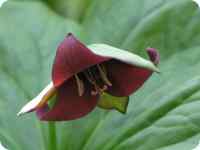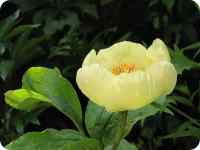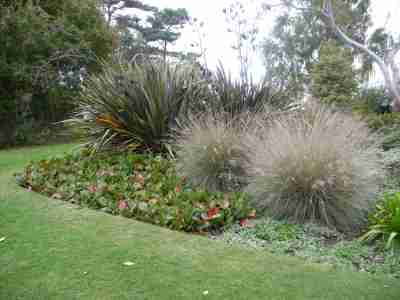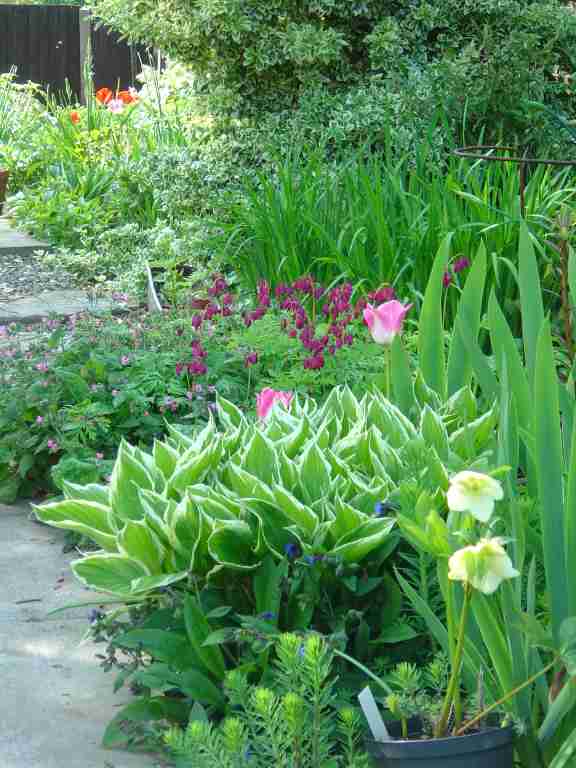 Trillium erectum |
Newsletter |
 Paeonia mlokosewitschii |
Contents
- Spring Thoughts from the Chairman
- Editorial
- Winter Hopes
- A Riverside Garden .... done!!!
- Crocosmia 'Croesus'
- The Mid-winter Musings of a Frustrated Gardener
- Specialist Groups
- Beth Chatto Revisited
- A History of Margaret's Garden (coffee morning 19 May)
- Aberglasney Garden and the National Botanic Garden of Wales, Carmarthenshire
- A Cautionary Tale
- Winter Wonders
- Early Warning
- Can You Help Us in Our Garden?
CORNUCOPIA
Cornucopia is the twice-yearly digest of the best writing from the Newsletters of the HPS local and specialist groups. To subscribe send a cheque payable to ‘The Hardy Plant Society’ for £2.20 (1 year) or £4.40 (2 years) to: Pam Adams, HPS, Little Orchard, Great Comberton, Pershore WR10 3DPArticles
Spring Thoughts from the Chairman
This may be the spring issue and in the garden there are some signs of new life and the cycle starting again but you have to wrap up warmly and search diligently for evidence.
With the new year we have had a few changes. Angela Downton has assembled a very interesting programme for 2010: her first event, in January, was from Richard Fishbourne who travelled from Hereford in appalling weather to talk to us. The committee received many telephone calls to check if the meeting was cancelled due to the snow. But with our Dunkirk spirit, the show must go on. Most of the committee made it so we felt at least we had a showing for the speaker. Then the miracle happened and 25 hardy souls arrived. It was a very good meeting: plenty of interaction between audience and speaker and genuine interest in his worms. We learnt some surprising facts about worms. A comment heard at the tea break: “It is so good to get out of the house and talk about something other than the weather.”
I would ask you all to consider what skills you could offer to the group. I joined having bought a house with rather a lot of ground, hoping to improve my gardening skills and to acquire plants that were rarely seen in garden centres. After a very long stint in the kitchen washing up, Pippa said "Do not mutter, get on the committee and do something about it." She was right and I did in 2004. I still did the washing up, but attending the committee meetings made me realise there is more to the group than an hour and a half on the second Saturday of the month. David became Secretary in 2006 and our present Treasurer took office in 2008. Most of the committee has held office for three years plus.
Our group thrives on change and challenge. We have led the way nationally by introducing one sub per year and the group did not flounder but actually flourished. Having 100 members on your list but only 40 coming to meetings is a hollow statement. We offer a very full programme of weekends away and day outings besides the monthly meeting. But to be successful we must constantly move forward so I am asking you to consider if you can take up a role on our committee and lead the group forward to greater adventures in the future.
Well if the gardens are a little behind this spring, the chickens have not changed their habits and the young cockerels are causing mayhem in the field as their spring ardour is roused. I must go out and protect the girls. Free to a good home - beautiful Light Sussex cockerel ( I have three), very lively disposition.
Editorial
Thank you to all those who contributed to this spring edition of our Newsletter. I hope you enjoy the mix of information about future events, reports and musings about gardens and, most important, plants. Please get in touch if you have any comments on the Newsletter. The copy date for the autumn edition is 16 October.
Winter Hopes
December 16: The HPS seed list has dropped through the letterbox. I really must not have any more plants in the garden. It is time to cut back and not let the garden get on top of me. But I am like a woman who sees no need for contraception - the more seedlings/children the better. Who doesn't like to see things grow? I get a thrill from seeing little green shoots emerging from brown compost, each one vying for light and air and a chance to live.
I glance through the HPS list; shall I try some Agapanthus 'Delft'? It sounds a beautiful blue; would it be so different from the Headbourne ones? Down the list to Aruncus aethusifolius, yes please - great creamy white plumes would look great in the shady shrubby border. Down the alphabet to 'C' and Campanula alliariifolia. You can never have too many campanulas - I hope these will be white. Gladiolus papilio, little white butterflies, lovely - yes please, and on to Hesperis matronalis, again white. They smell lovely, are good for cutting and make good fillers up. Not all my choices are white - Inula hookeri will be yellow, as will some of the Primula Harlow Carr hybrids, 'dappled, brindled', as Gerald Manley Hopkins says of finches' wings.
I have sent my cheque off to this splendid woman who organised the seed exchange and hope I shall not be disappointed.
January 11: Now I look out upon a snow-white garden. It will be several weeks, months before any of the seeds are sown. I am impatient, but warmth and spring will come - it always does.
A Riverside Garden .... done!!!
It was going to be expensive, and not many would think it a good idea, but I decided that my retirement lump sum was going to pay for my garden to be redesigned. I wanted to be able to garden well into my ageing years, and if I didn’t do something about the steep steps soon then I would begin to find the climb too demanding. I also wanted a bit of wow! in the garden … something I seemed incapable of creating alone. So I found a designer I liked who specialised in steep gardens and took the plunge.
Work started early March 2009. The workforce varied depending on the task for the day, but normally there were two – Rob (coffee no sugar) and Vern (coffee two sugars). They were joined on the first day for the big clearing by Liam (weak tea, two sugars), Steve (tea, no sugar) and the designer Andrew (coffee, one sugar). They took up all the plants in the garden, potted up the ones we were going to keep, and made a start.
The estimate was for the job to take 6-8 weeks and they made good progress initially. But the team didn’t have another job waiting for them and their working day got shorter and shorter. Neighbours noticed this and seemed gleefully to mention it at every opportunity. The week of the Cheltenham Races was worst: the lads arrived late having placed their bets, had long lunches to watch the races, and left early to pick up winnings. Progress was difficult to spot at times.
But it did start to take shape and by May the hard landscaping was complete. About half the plants we had potted up were still alive and the fun part began … or at least I would have found it fun if only I’d been there. Our week’s holiday to Fort William and the Isle of Skye had been planned for a long time. But the landscapers got a new customer and suddenly showed how quickly they could work when they needed to. By the time we got back from Scotland all the plants were in and the job was done. I was disappointed but they probably got on a lot quicker without me.
I didn’t dare move or buy any plants for ages. The garden looked lovely and I didn’t want to spoil it. But flowers fade and something else needs to take over - my confidence slowly grew and I started to make the planting ‘mine’ .
It’s six months on now, and you’ll ask me was it worth it, and am I pleased? The truth is, I’m thrilled to bits and have been every day since it was finished. I can’t begin to tell you the pleasure I get every single time I walk out there, and the hours I can spend pottering up and down my now gently sloping path. It does have some wow!, or at least I think it does, and that really is what matters.
Will I have an HPS coffee morning here? ……… no, there really isn’t room - it’s all far too small. But if you’re interested, then do come as a friend for coffee sometime …… I’ll be delighted to show you round my new bit of paradise on the riverside!
Crocosmia 'Croesus'
When we moved to this house 25 years ago the garden was full of montbretia which over time I have dug out, though not with 100% success. In fact I have re-thought my attitude to this vigorous plant which is undemanding of soil and aspect and flowers later in the summer when many plants are past their best. I now have seven varieties of crocosmia in my small garden - 'Lucifer', 'Philippa Browne', 'Dusky Maiden' (sold to me from a WI market stall as Dusty Maiden!), 'Severn Sunrise' (my personal favourite), 'Limpopo', 'Zeal Tan' and 'Croesus'.
'Croesus' came from Bob Brown’s and was not what I had gone there to buy, as so often happens when I am let loose in a good nursery. I was intrigued by the name (for those of you who don’t know, Croesus was a legendary rich king of Lydia in Asia Minor) so home it came and was duly planted in a border. Two summers came and went without a trace of a flower so I replanted it in a different position which I hoped might suit it better. It obviously did as it then obliged with yellowy orange flowers. However next summer it was back to all leaves and no flowers. It obviously is a fussy character especially where my garden is concerned and I began to think about digging it up (my philosophy is in a small garden every plant has to earn its keep).
This year I thought I was in for the same until September when I noticed the flower buds forming and it has rewarded me with a glorious amount of bloom all through autumn. In fact, at the time of writing in late November, there are still a few flowers left. So I hope it has now got into its stride and will oblige every year, especially if it flowers as late as it has. I’m glad I didn’t dig it up - perhaps it heard my threat!
The Mid-winter Musings of a Frustrated Gardener
I try to get out into the garden every day, even if it is just to take a look round; but for a period this winter I have been deterred by snow and sub-zero temperatures. This year’s winter projects are on hold. The partially completed ‘earthworks’ to improve access to a row of blackberries have frozen solid and the ditch I was clearing is now full of meltwater and abandoned heaps of bramble.
We had been burning these in situ, because of the difficulties of hauling them out, but we rarely burn anything these days, not since I bought a business-like shredder. Forget about the ride-on mower, this is my favourite garden toy! I keep the shreddings in a separate heap to start rotting down before adding to my four-bin compost system. All of this supports a healthy population of slowworms. Making compost is my favourite task, but for me there is no diving in with a fork to turn it, for fear of spearing one of the occupants.
Next to the composting area, in the shade of a neighbour’s trees, is the Mark 1 fern bed. The first fern I ever grew was Dryopteris filix- mas, the male fern. This is very drought tolerant and even grew in my father-in-law’s sunny sandy garden. As my collection grew, I moved on to more demanding species and eventually moved them all to a new moister bed in more permanent shade. This was carved out of an area of roughish grass, together with a holding bed for young plants waiting for a permanent home. I have a strict rule about this – if they linger there too long, out they go – either to a plant sale or the compost heap.
The original fern bed has become the thugs’ bed. One of which is Edna’s ‘yellow thing’, alias Lysimachia punctata, yellow loosestrife. A well-meaning neighbour gave this to me about 30 years ago and I am still trying to get rid of it! The moral here is that not all gifts are to be welcomed. But there are precious gift plants like the Hepatica given to me by a dear friend when she left her beloved garden to live in residential care. She had been given it by her father, who acquired it from the garden of the ‘big house’ on the estate where he worked. Acquired it – I wonder how?
As well as plants that remind me of people, I love those that remind me of places. As a result I have plants native to Australasia and South Africa. Is this the winter when I shall really regret dabbling in the Half Hardy world? Hardiness is a more complicated concept than I had realised. For example, I have an Agave and other succulents, rescued when their owner emigrated, which over-winter well in a raised bed, protected by a purpose built polycarbonate roof. They got too big to keep in pots, and then outgrew the pop-up plastic greenhouse used in previous years.
In March it will be five years since I ‘retired’ and started a long-term project to re-work our quarter acre garden – I can’t function without a project. After the fern bed came the Bog garden. In truth this isn’t a true bog garden, despite digging down and laying a perforated pond liner, but it does dry out more slowly than the rest of the garden. The coloured stems of Cornus and a couple of robust, leathery evergreen ferns, Blechnum chilense and Crytomium falcatum provide winter structure.
The Gravel garden is still work in progress because what I didn’t know until I started was that this area is poorly drained because the underlying clay is very near the surface. At first the contrasting Libertia peregrinans and Euphhorbia characias ‘Portuguese Velvet’ looked a treat, but after a prolonged period of heavy rain the Euphorbia declined rapidly over just a few days. Waterlogged roots, I guess. The Libertia and a lovely cream form of Eschscholzia californica, Californian Poppy, continue to do well with their shallow root systems.
It is now late January, the evenings are getting lighter, so high time to look forward. A couple of days ago the weather was a touch more inviting so I did some pruning. After a cuppa there was still time to get the debris shredded before dark. Activity at last - I feel better for that!
Specialist Groups
Do you belong to a Specialist Group? I belong to the Hardy Geranium and Pulmonaria Groups and they are an essential part of my HPS “experience”.
Do not be deterred by the word “Specialist”; the members are all friendly enthusiastic gardeners who like to discuss their favourite plants and the experts are happy to share their knowledge with beginners. Members receive two newsletters a year (now in colour) and the Geranium Group have a free seed exchange. There is an annual meeting which is inexpensive but often a memorable occasion, with Hardy Planters coming from across the country. The morning session usually has a talk or workshop with a plant display and a sale; it brings an opportunity to see and buy unusual plants. It is followed by an afternoon garden visit; I particularly remember Brian Dockerill’s woodland garden in South Wales and David Victor’s outstanding borders in Bedfordshire. The weather was kind for both visits!
This year Pulmonaria Day is in Hampshire and Geranium Day (June 19th) in Worcestershire. Since the latter is so easy for you to attend, why not join the Hardy Geranium Group and try a Specialist Group? Contact details are in your national HPS newsletter.
Beth Chatto Revisited
Having been members of the group which visited The Beth Chatto Garden in June 2007, on our East Anglia tour, Colin and I thought it would be interesting to revisit it as part of a week we spent in Suffolk last October.
It had been a sunny day in June: in October it was grey and chilly. But the welcome was warm (as was the soup in the tearoom) as we started, inevitably, in the Gravel Garden. Here nearly everything was over, but Verbena bonariensis, stipa and other grasses, with an edging of catmint, and behind them orange and grey foliage, and behind again, sheltering conifers, gave a satisfying grouping.
We set off round the Water Gardens where some of the gardeners were doing some of the autumn tidying - the size of the task gave us pause. I was delighted by a tiny Aster ericoides 'Snow Flurry', whose name describes it exactly. In the same grouping were bronze foliage, other taller blue and white asters and rudbeckia. A birch with white bark standing alone was the focal point among the bronze, orange and brown foliage, and blue viburnum berries gave other interest. The placing of the trees, both enclosing and structuring the garden, struck us forcibly on this visit, whereas in June our eyes had been focussed lower down. We were also very aware that the structure is achieved with very little, effectively no, hard landscaping - again, something we had not thought about in 2007.
The Reservoir Garden produced, for us, the absolute star plant of the day - Cortaderia selloano 'Sunningdale Silver'. Pampas grass has never been among my favourite plants, but this was stunning with its tall, still perfect, silver plumes above a soft autumn mix including teasels and cornus - red stems, leaves a mix of red and green - with Helianthus 'Lemon Queen' flowering behind.
Also in the Reservoir Garden was a bed partly planted with very large phormiums  with arching curves of black seedheads and two huge clumps of silver grass with bergenias in front. The effect was of striking silver and grey.
with arching curves of black seedheads and two huge clumps of silver grass with bergenias in front. The effect was of striking silver and grey.
Colin much admired the enormous array of succulents in pots by the house, and the nerines by the greenhouse, again in pots, which ranged from white through clear pink and salmon to pale scarlet, were very cheering in such subdued light.
The border of asters which had started as a stock bed for the nursery wasn't the most successful part of the garden - too much pinky-mauve for us - nor was it the most successful aster border. But, then, we're spoilt at home by Paul Picton being local. We did however take to Aster lateriflorus 'Coombe Fishacre' with its pinky-white petals and almost brown centre.
As we came out past the entrance kiosk to leave we noticed a very dark purple-brown Heuchera 'Plum Pudding', epimedium leaves, a low-growing viburnum and hakonechloa, with a low grey plant we didn't recognise, growing under a very large tree. This lovely grouping sent us on our way with a low-key autumnal flourish, very pleased to have seen the garden again at such a different season.
A History of Margaret's Garden - coffee morning 19 May
My late husband Richard and I moved to Broadwas and into a newly-built house in February 1968. The back garden consisted of a rectangle of rough field full of sow thistles approximately 110' x 50' in size. I began a border down the right-hand side by digging and weeding each day a patch about 6' x 4' and whilst I was doing this we had the remainder of the garden rotovated and turf laid.
I began a border down the right-hand side by digging and weeding each day a patch about 6' x 4' and whilst I was doing this we had the remainder of the garden rotovated and turf laid.
In 1969 I started a veg patch by lifting a small area of turf and continuing to do so every few weeks until I had made a veg plot 20' x 45'. Richard meanwhile was making the terrace and raised flower beds. My greenhouse arrived in 1971 as a Mothers Day present and is still in all the year round use.
While the children were growing up the borders were narrow as swings, climbing frame and a full sized badminton court took precedence. As soon as they left home we started digging out the pool and widening the borders.
2000 saw a massive change when I gave in, and Richard and his friends erected a large railway on which to run live steam engines. This went through and over several borders and across my veg. bed. It was dismantled in 2007 and I have been doing my best to re-establish the borders since then.
More photos of Margaret's garden
Aberglasney Garden and the National Botanic Garden of Wales, Carmarthenshire
Having watched a programme on television about the restoration of Aberglasney House and Garden, we planned to visit en route to our holiday destination in Mid Wales. The pre-17th century house had had a chequered history and was abandoned in the 1970's. The house fell into disrepair and was ransacked. The garden became overgrown with scrub to such an extent that, during clearance, a beautiful cloister walk was discovered.
We travelled in the morning, arriving in time to have our picnic lunch in the car park; there is a restaurant which serves teas and light meals. The garden is designed in a formal style appropriate to the house; there is one area for which Penelope Hobhouse was responsible which is more modern. There remains a lot of work to be done in the house but the conference room and the "ninfarium", an indoor garden with a glass roof created in what was once the courtyard of the house, are complete. The Aberglasney Restoration Trust was formed in the 1990's by a few enthusiastic and determined people, and it is truly impressive how enough money has been raised to enable this lovely house and garden to be rescued from their total dereliction.
Half a day is sufficient to appreciate Aberglasney, and we stayed in the area overnight before making less than an hour's journey to the National Botanic Garden. A whole day is required there: we arrived at 10a.m. and tore ourselves away at 5p.m., there is so much to see. There is a huge glasshouse, a tropical house, a very big walled garden and much more that there is not space here to describe. Although we were there rather late, the middle of October, we could see that the planting was both interesting and spectacular and, because the garden is relatively new, had not had time to need overhauling. The weekend was a great start to our holiday and, that too, was very enjoyable.
| Aberglasney | Tel: 01558 668998 |
| National Botanic Garden | Tel: 01558 668768 |
A Cautionary Tale
In the following little tale the ladies mentioned were gardening in the mid-eighteenth century. The tale is taken from Jenny Uglow's A Little History of British Gardening and she quotes an earlier writer, Todd Longstaffe-Gowan, as her source.
“Mrs Delaney, like gardeners before and since, could never resist a beautiful new plant even if she had no room for it: when she visited the botanist Dr Fothergill in Essex, she moaned that she ‘crammed my tin box with exotics, overpowered with such variety I knew not what to chuse!’. She was not the only extravagant town gardener: Eliza Robertson's bills for her ‘improvements’ at her house in the Paragon, Blackheath, were so huge that she was arrested.”
Winter Wonders
This winter has proved challenging with temperatures dipping so much below freezing. I expect that it will be May/June before we can assess the full effect on the plants in the garden. I wonder if the Azara microphylla ‘Variegata’ will survive? It is looking very sad just now. However some have excelled with the cold.
The best for me has been Trachelospermum jasminoides 'Variegata', also known as variegated confederate jasmine or variegated star jasmine. It is very similar to one which I grew in a previous garden and loved its wonderful heady jasmine scent. In my current garden I wanted to plant it again but was attracted by the idea of a cultivar that becomes more attractive in winter as well as having the jasmine-scented flowers in summer. I chose a spot outside the lounge window and have been richly rewarded with the effect. It is an evergreen twiner with privet-like glossy green leathery leaves. In summer these have some creamy-yellow variegation. However in autumn and winter these turn bronze and pink with a dash of cream. The plant has not flowered as prolifically as the species plant did for me in our Birmingham garden. I do not mind that as I can admire the foliage throughout the darker months without even having to go outside.
Last year I bought a plant of Trachelospermum jasminoides ‘Waterwheel’. Its leaves are a little narrower at about 5mm. This gives it a more spiky appearance. It is still an attractive evergreen plant, without the remarkable leaf colour, and will hopefully provide a “full stop” at the end of a length of trellis. The label states that it also has jasmine-scented flowers. I was a little deflated to read in The Garden (Vol.130 Part 6 page 424), after I had brought the plant home, that the author has not known it to flower in this country. We will see ………
I was surprised to find myself admiring Ophiopogon planiscapus ’ Nigrescens’, also commonly known as the Lily turf, Black Dragon or Ebony Knight. I have seen it described as a stunning plant. I have never seen it in those terms. It is grass-like whilst being a member of the lily family. The dark evergreen leaves turn black if allowed exposure to full sun. I have used it in the garden to give contrast to other plants such as snowdrops and Sedum rupestre ‘Angelina’. It grows to 12cms and has violet flowers from June until August. These are followed by black berries and it is these that have caught my eye this winter. They have glistened in the winter sun, sometimes just showing above a covering of snow. Lovely!
Another surprise was a cyclamen that I bought, I think from one of our speakers, a couple of years ago. The label has disappeared: where do they go? The leaves and flowers are bigger than those of the species Cyclamen coum so I think that it must be a cultivar. The plain green leaves appeared in the autumn. It started to show its “lipstick pink” flowers mid-December, disappeared below the various coverings of snow and just got better and better. It is still in flower as I write this in mid- February. What a joy to see the vivid pink flowers and green leaves nestling in the snow.
And now we have the snowdrops …………
Early Warning
Little did I think, when planning this year's garden tour that so many people would have commitments around the end of April and although dates and details were announced as long ago as September last year many members were disappointed. I have already been asked if I am working on a tour for next year and if so whether it will be scheduled for June as in previous years. The answer to both questions is 'yes', so please earmark the dates 16-19th June if you would like to join us. Full details will be announced in the autumn.
Can You Help Us in Our Garden?
 You probably already know that a group mainly of Hardy Planters plants and maintains the Pershore Perennial Garden, the herbaceous perennial garden at Pershore College. Recently some of our stalwart band have decided that other commitments mean they can no longer garden there. Would you like to join us? We garden as a group or as smaller groups concentrating on one part of the garden, or some of us spend some time there on our own - to suit what else we're doing.
You probably already know that a group mainly of Hardy Planters plants and maintains the Pershore Perennial Garden, the herbaceous perennial garden at Pershore College. Recently some of our stalwart band have decided that other commitments mean they can no longer garden there. Would you like to join us? We garden as a group or as smaller groups concentrating on one part of the garden, or some of us spend some time there on our own - to suit what else we're doing.
If you're interested, please contact me and I'll explain the setup. I'd be very happy to meet you at the garden and show you around (do a bit of gardening?) if you'd prefer that to meeting more of the group on your first visit.